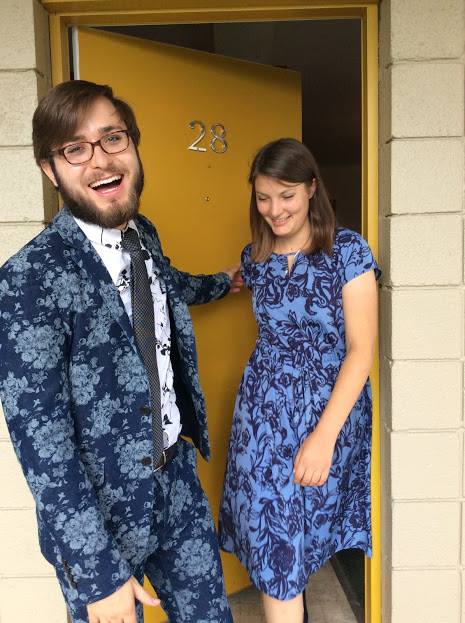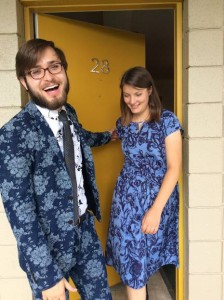Fabulous Families: A Queer Perspective on Siblinghood

By Christian Frandsen
 Thanks to the considerate folks at Facebook, these days we have far more opportunities to celebrate obscure holidays than we ever did before. All it takes is a simple click into the status update field and the screen will cheerfully let you know what to commemorate that day and even attach a cute little icon to your words. As I logged into Facebook several Sundays ago (which I’m slightly ashamed to say was the first thing I did upon waking), I was delighted by the holiday I was prompted to acknowledge—National Sibling Day. Being someone who is surprised by how unexpectedly Christmas sneaks up on him every year, I would never have had the slightest inkling of this holiday without Facebook’s help, much less done anything to mark it. Luckily for me, though, I was not only granted some wonderful quality time with a handful of my ten siblings, but I was also given a venue to pontificate on the richness of meaning held in the word sibling. The following is an adapted summary of my remarks and the ensuing discussion on siblinghood from last month’s Affirmation Millennials FHE.
Thanks to the considerate folks at Facebook, these days we have far more opportunities to celebrate obscure holidays than we ever did before. All it takes is a simple click into the status update field and the screen will cheerfully let you know what to commemorate that day and even attach a cute little icon to your words. As I logged into Facebook several Sundays ago (which I’m slightly ashamed to say was the first thing I did upon waking), I was delighted by the holiday I was prompted to acknowledge—National Sibling Day. Being someone who is surprised by how unexpectedly Christmas sneaks up on him every year, I would never have had the slightest inkling of this holiday without Facebook’s help, much less done anything to mark it. Luckily for me, though, I was not only granted some wonderful quality time with a handful of my ten siblings, but I was also given a venue to pontificate on the richness of meaning held in the word sibling. The following is an adapted summary of my remarks and the ensuing discussion on siblinghood from last month’s Affirmation Millennials FHE.
Sibling. Sister. Brother. These words carry so much in their few syllables. The relationships they represent are often the longest and most intense of a person’s life. In the case of biological and adoptive siblings, these relationships last through and even transcend the lifespan and continue to exist across any physical or metaphysical gap. A sibling can be a best friend or a bitter rival, charmingly annoying or indifferent and estranged. Siblings can meddle and muddle and support and sustain. Siblings can bicker with us and they can better us. Some siblings exist in relation to us as unchosen facts of life. Other siblings are chosen and become such through legal or spiritual ties that we enter into.
Scriptural literature overflows with sibling narratives. The Old Testament is full of the weird and cautionary. Cain and Abel’s story reveals the potential for violence. The untold stories of Adam and Eve’s other children imply incest. Isaac and Ishmael fought. Jacob and Esau fought. Rachel and Leah fought. All of Jacob’s sons fought and they even tried to kill Joseph. Miriam, Aaron, and Moses had their bad moments and Moses and his step-brother the Pharoah didn’t quite end on good terms. David’s older brothers mock him. The New Testament, for all its messages of inclusion and love, still has tells its fair share of conflicted sibling stories. The two brothers in the parable of the prodigal son don’t like each other too much. The sets of brothers among Jesus’ disciples tend to bicker and compete. Mary and Martha get jealous and don’t always get along. We know virtually nothing of Jesus’ own siblings or his relationship with them—just that he had them. The Book of Mormon is no different. Laman and Lemuel try to kill Nephi multiple times and Nephi is quite the prick to them. Political intrigue among siblings abounds. The sons of Mosiah got each other into all sorts of trouble (though they made amends and loved each other dearly later on). Clearly, Holy Writ has a thing or two to say about all the ways sibling relationships can be dysfunctional.
The doctrines and histories of the Restoration, however, reveal more glimmering facets of what siblinghood can be. Joseph Smith’s own sororal and fraternal relationships were tender and caring, from what we can understand. The Mormon understanding of the afterlife (including the idea of eternal families) began to emerge following Joseph’s prayers about the eternal well-being of his deceased brother Alvin. That understanding expanded and developed into a very familial concept of redemption and heaven in which our sibling relationships—especially with Jesus Christ, our elder sibling and savior—are inherently salvific. Through affectionate appellations like “Brother Joseph” and “Brother Brigham” (and I imagine “Sister Emma” and “Sister Eliza”) as well as sacred ceremonies, early Mormonism gave life to the idea that siblinghood transcends a biological and genetic connection between off-spring of the same parents, but is adoptive and expansive and inclusive and spiritual and crucial to the establishment of Zion and the saving of the human family. This persists in our present-day practices. We address each other as sister and brother and we think of our congregations as ward families. In singles’ wards, we divide into “families” and unofficially designate the group leaders as parents and the participants as siblings. Among missionaries, who are far from their families for perhaps the first time, intricate kinship systems exist with mothers and fathers and step-parents and siblings and uncles and aunts all determined by who trained whom and what roles of influence missionaries play during the course of service. Family life and relationships are so deeply carved into our psyche that they give meaning to almost every sector of our lives.
Mormons, however, are not the only group to cherish and redefine and explore the meanings of family. Queer culture has a history of establishing family structures and bonds of kinship in order to survive and thrive. At BYU, we use the code word “family” as a means of discreetly communicating to each other who is and is not queer. In the world of drag, there are drag families with mothers and daughters and sisters and fathers and sons. A few decades ago in New York, black and brown young people, usually homeless and disowned from their biological families because of a culture of transphobia and homophobia, created the ballroom scene—a circuit of friendly but fierce competitions that allowed these disenfranchised children to slay, celebrate, flourish, and feel their fantasies. This vibrant subculture found structure and stability in its houses. Each house had a name and a mother (and sometimes a grandmother or father)—a resilient queer who had survived the difficulty of disownment and street life and had achieved enough stability despite their continued poverty to care for the younger kids who were more freshly expelled from their homes. These terribly impoverished young people found both emotional empowerment and critical resources like food and medical care through these houses. The members of these houses really were families—they took on the house name and loved, cared for, and protected each other in the face of poverty and violence. This community was documented in the brilliant film Paris is Burning, which is available on Netflix and which is required reading (like seriously, important homework) for everyone in and around the LGBTQ community.
To be born queer is to be born into a second family which is only discovered later in life. Just as we don’t choose our siblings but hopefully learn to love them and take pride in our family identity, we don’t choose our queerness but hopefully learn to love it, love our queer family, and take pride in our queer identity. Furthermore, the experience of being queer ties us together in a peculiar way that is different from the bonds we share with our biological or adoptive siblings (unless our siblings are also queer) because to find this family we must first accept ourselves to some degree and then seek LGBT siblings out.
It is beautiful to belong to this queer family, but it should not be romanticized. Just as the scriptures tell many a cautionary tale of sibling relationships fraught with conflict and abuse, we also can be guilty of conflict-ridden and even abusive interactions with our queer siblings. Many of us know the awful feeling of being vulnerable and coming out to a family member only to have them say “no, you can’t be gay—it’s just a phase” or invalidate our identity that we’ve painfully (and perhaps tentatively) come to claim. Harder still is the experience of coming out to a family member or friend or introducing a partner only to be completely rejected and perhaps thrown out. These are potentially traumatic events that can wound a family. Yet we as a queer family are sometimes prone to the same hurtful behaviors. Sometimes we don’t believe our friends when they tell us they’re bisexual and we might even go so far as to tell them so. Sometimes we misgender our transgender siblings and fail to put effort into using their pronouns correctly. Sometimes we erase non-binary or genderqueer identities simply because it’s an experience that doesn’t line up with our own. Sometimes we feel threatened by the relationships that others form that are different from our own, so we condemn them. Sometimes our own internalized homophobia or queerphobia leads us to police or insult or shame those who are too feminine, or too fierce, or too fabulous. Sometimes our desire to assimilate and be normal to mainstream society misguidedly motivates us to alienate and reject queer people who are non-white, non-cis, non-male, non-binary, or non-normative. I only list all of these things because I have been guilty of every single one of them.
The root cause of this type of dysfunctional family behavior is not difficult to find. Most of it is connected to our own unhealed pain and unresolved trauma. It stems from our own sense of insecurity in a world that is too often violent and oppressive. It’s understandable, but it’s not right.
As a queer family, we need each other—literally each “other” that we perceive as separate or apart from us—to heal our wounds, strengthen each other, and stand up for each other at all times and in all places. Just as a family working through conflict can come together through active and empathetic listening, humility, and a commitment to radical love and acceptance, we can do the same. Let’s learn the lessons that the scriptures can teach us. Let’s practice Christ-like love and solidarity. Let’s celebrate one another in all of our uniqueness and quirk and charm and beauty, just like all of those Facebook holidays. Let’s be good siblings to each other.
That was so beautifully written that I’m inspired to share this. Thank you.